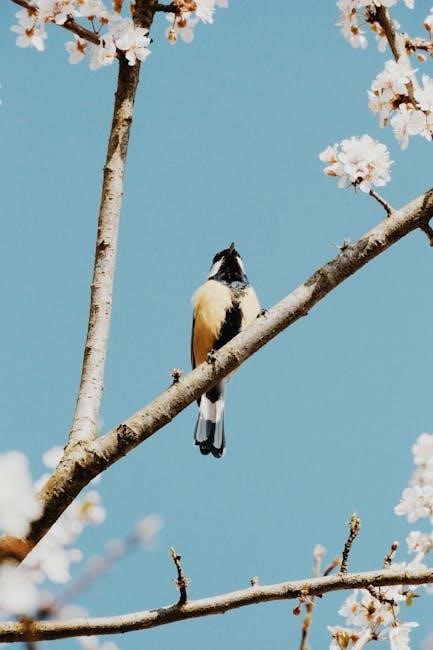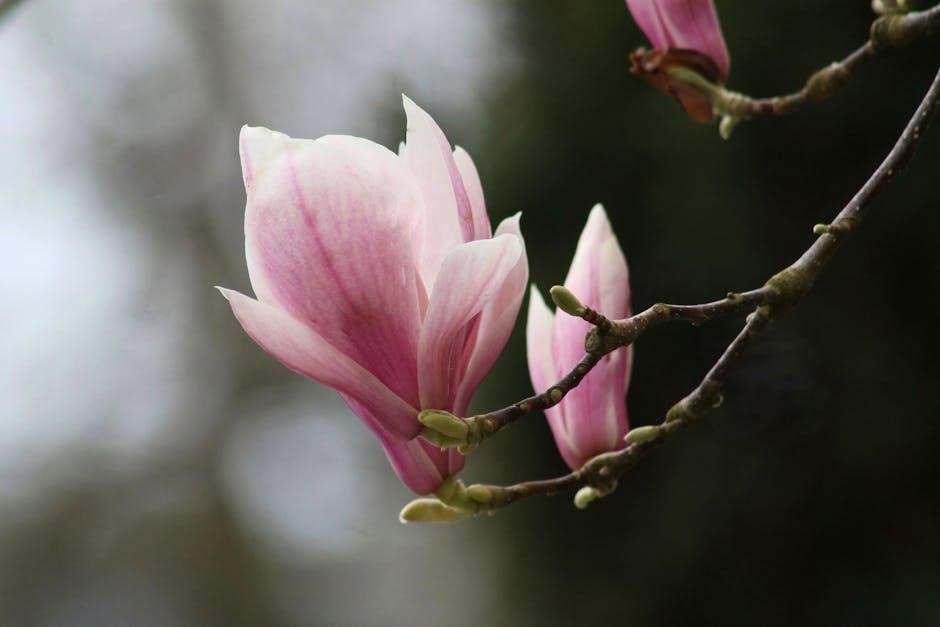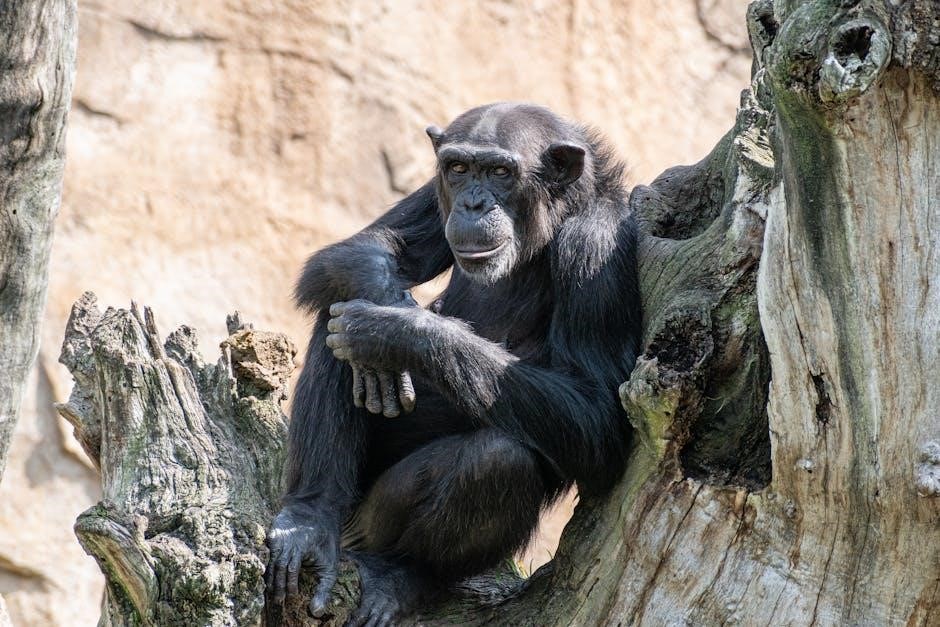The enchanting Amazon Rainforest sets the stage for The Great Kapok Tree, a captivating tale by Lynne Cherry, highlighting the tree’s central role in the ecosystem․
Through its unique narrative, the book explores themes of environmentalism and the interconnectedness of life, leaving a lasting impact on readers of all ages․
Overview of The Great Kapok Tree
The Great Kapok Tree, a towering giant in the Amazon Rainforest, stands as a symbol of life and resilience․ Reaching heights of over 60 meters, it is one of the largest trees in the rainforest, providing a habitat for countless species․ Its expansive canopy and deep roots support a vibrant ecosystem, sheltering animals like monkeys, jaguars, and macaws․ The tree’s unique seed pods produce soft, water-resistant fibers, making it a vital resource for both wildlife and humans․ Its ability to thrive in challenging environments underscores its importance as a cornerstone of the rainforest, highlighting the interconnectedness of all living beings within this ecosystem․
Importance of the Kapok Tree in the Amazon Rainforest
The Kapok tree is a keystone species in the Amazon Rainforest, playing a vital role in maintaining the ecosystem’s balance․ Its vast canopy provides shelter and food for countless animals, from monkeys to birds, while its deep roots stabilize the soil, preventing erosion․ The tree’s unique seed pods produce kapok fibers, a sustainable resource for humans․ As a hub for biodiversity, it supports intricate relationships between flora and fauna, ensuring the survival of many species․ The Kapok tree also contributes to carbon sequestration, helping to regulate the climate․ Its presence is essential for the rainforest’s health, making it a cornerstone of ecological and economic importance in the Amazon region․
A man is tasked with chopping down a Kapok tree but is persuaded by the forest’s creatures to spare it, leading to a change of heart․
The Great Kapok Tree: A Tale of the Amazon Rain Forest
The Great Kapok Tree: A Tale of the Amazon Rain Forest by Lynne Cherry is a poignant story set in the heart of the Amazon Rainforest․
A man is tasked with cutting down a massive Kapok tree, but as he rests at its base, the forest’s creatures plead with him to spare their home․

Through their voices, the man learns about the tree’s vital role in the ecosystem and the lives it sustains, leading to a profound transformation․
The book highlights the interconnectedness of life and the importance of preserving nature, offering a powerful message about environmental stewardship․
Its vivid illustrations and compelling narrative make it a beloved tale for readers of all ages, inspiring awareness and appreciation for the Amazon’s biodiversity․
Lynne Cherry and Her Work
Lynne Cherry is a renowned author and illustrator, best known for her children’s books that explore nature and environmental themes․
Her work, including The Great Kapok Tree, combines vivid storytelling with stunning visuals to educate and inspire young readers about the natural world․
Cherry’s passion for the Amazon Rainforest and its inhabitants is evident in her detailed illustrations and the heartfelt narrative of the Kapok tree’s significance․
As both author and illustrator, she brings a unique perspective to her stories, blending art and advocacy to highlight the importance of conservation․
Her books have become essential tools for teaching environmental awareness, fostering a deep appreciation for the interconnectedness of life on Earth․
Setting of the Story
The story unfolds in the enchanting Amazon Rainforest, where the towering Kapok tree stands as a symbol of life, surrounded by vibrant biodiversity and lush vegetation․
The Amazon Rainforest as a Unique Ecosystem
The Amazon Rainforest, depicted in The Great Kapok Tree, is a unique ecosystem teeming with life․ Its lush canopy, diverse flora, and abundant fauna create a habitat for countless species․ The Kapok tree, a giant among them, shelters a vibrant community of animals, from monkeys to jaguars․ The forest’s layers, from the emergent trees to the understory, support intricate interactions․ This biodiversity hotspot is crucial for global ecosystems, producing oxygen and regulating the water cycle․ Lynne Cherry’s story highlights the rainforest’s beauty and its role as a living, interconnected web of life, emphasizing its importance to the planet․ The Amazon’s uniqueness lies in its ability to sustain such richness, making it a vital natural wonder․

The Role of the Kapok Tree in the Rainforest
The Kapok tree, a towering giant in the Amazon, plays a vital role in the rainforest ecosystem․ It provides habitat and sustenance for numerous species, from monkeys to birds․ Its expansive canopy offers shelter, while its trunk and branches support a variety of plant life․ The tree’s deep roots stabilize the soil, preventing erosion and maintaining water cycles․ In The Great Kapok Tree, Lynne Cherry illustrates its significance as a keystone species, essential for the survival of the rainforest community․ The tree’s presence ensures biodiversity, making it a cornerstone of the Amazon’s ecological balance and a symbol of nature’s interconnectedness․ Its role underscores the importance of preserving such vital elements of the rainforest․
Biodiversity of the Amazon Rainforest
The Amazon Rainforest is renowned for its extraordinary biodiversity, hosting millions of species, many found nowhere else on Earth․ This lush ecosystem is home to iconic animals like jaguars, monkeys, parrots, and snakes, as depicted in The Great Kapok Tree․ The rainforest’s intricate web of life includes countless insects, birds, and plants, all interconnected in a delicate balance․ The Kapok tree itself serves as a microcosm of this biodiversity, sheltering a variety of flora and fauna․ This rich biodiversity not only highlights the Amazon’s ecological importance but also underscores the urgent need for conservation efforts to protect this invaluable natural treasure from threats like deforestation and climate change․

Characters in the Story
The story features a man tasked with cutting down the Kapok tree and a vibrant community of animals living in it, highlighting their interconnected lives and roles in the ecosystem․
The Man and His Mission
The man in The Great Kapok Tree is tasked with cutting down the majestic tree, driven by a mission that initially fuels his determination․ However, as he begins his work, the sheer scale of the task and the oppressive rainforest environment start to take their toll․ Despite his resolve, the man grows weary, and the sounds of the forest, along with the creatures’ subtle interventions, begin to influence his perspective․ His mission, while clear at the start, becomes increasingly questioned as the forest’s inhabitants make their presence known, challenging his purpose and ultimately leading to a profound shift in his understanding of the natural world․
The Animal Community of the Kapok Tree
The Kapok tree is home to a vibrant and diverse community of animals, each playing a vital role in the ecosystem․ Monkeys, jaguars, parrots, and snakes are among the many creatures that inhabit this majestic tree․ As the man rests at its base, the animals begin to communicate with him, sharing their perspectives on the forest’s importance․ The monkeys express concerns about human actions, while the jaguars and snakes emphasize the interconnectedness of all life․ This collective effort by the animal community highlights their dependence on the Kapok tree and the rainforest, underscoring the delicate balance of nature․ Their voices ultimately contribute to the man’s realization and transformation․
Themes of the Book
The book explores themes of environmentalism, highlighting the Amazon’s biodiversity and the need for conservation․ It also addresses the impact of human actions on nature and the importance of community and interconnectedness among all living beings․
Environmentalism and Conservation
The Great Kapok Tree by Lynne Cherry is a powerful advocate for environmentalism and conservation․ The story vividly portrays the Amazon Rainforest as a fragile ecosystem, emphasizing the importance of preserving biodiversity․ Through the plight of the Kapok tree and its inhabitants, the book highlights the consequences of human actions on nature, urging readers to reconsider their relationship with the environment․ The narrative serves as a cautionary tale, stressing the need to protect endangered species and their habitats․ By focusing on the interconnectedness of life, Cherry inspires a sense of responsibility toward the planet, making it a vital tool for educating children and adults alike about the importance of conservation efforts․

The Impact of Human Actions on Nature
The story of The Great Kapok Tree underscores the profound impact of human actions on the natural world․ A man is tasked with cutting down the tree, unaware of the ripple effects this will have on the ecosystem․ As he begins his work, the animals of the rainforest voice their concerns, revealing the tree’s vital role in sustaining life․ This narrative illustrates how human interventions, often driven by exploitation, can disrupt delicate balances in nature․ The book serves as a poignant reminder of the consequences of deforestation and the importance of responsible stewardship․ It challenges readers to reflect on their own actions and their influence on the environment, fostering a deeper appreciation for nature’s interconnectedness․
Community and Interconnectedness
The Great Kapok Tree vividly portrays the deep sense of community and interconnectedness within the Amazon Rainforest․ The animals living in and around the Kapok tree work together to protect their home, demonstrating unity and cooperation․ From monkeys to jaguars, each creature plays a vital role in the ecosystem, highlighting the delicate balance of nature․ The story emphasizes how every living being, no matter how small, contributes to the survival of the community․ This theme underscores the importance of collaboration and mutual respect among all inhabitants of the rainforest․ The book’s message extends beyond the animals, reminding readers of humanity’s place within the larger web of life and the need to preserve such harmonious relationships for future generations․
Plot Development
A man is tasked with cutting down the great Kapok tree but stops after a transformative encounter with its inhabitants, realizing its vital role․ The Great Kapok Tree builds tension as the man’s perspective shifts from destruction to preservation, ultimately sparing the tree․ This pivotal moment highlights the story’s emotional depth and the power of empathy in altering human actions․ The narrative unfolds through the man’s journey, showcasing the Amazon Rainforest’s vibrant life and the interconnectedness of its creatures, leading to a resolution that emphasizes harmony between humans and nature․ The plot’s simplicity belies its profound message about environmental stewardship․
Key Events in the Story
A man is tasked with cutting down the great Kapok tree, but as he begins chopping, he grows weary and rests at its base․ During his sleep, the tree’s inhabitants—a diverse group of animals—approach him, sharing their perspectives on the tree’s importance․ Each creature explains how the Kapok tree provides shelter, food, and life, revealing the ecosystem’s interconnectedness․ These encounters deeply move the man, leading to his transformation․ By morning, he abandons his mission, sparing the tree and its inhabitants․ This pivotal shift highlights the story’s core message of environmental preservation and the impact of human actions on nature․ The events unfold seamlessly, creating a narrative that is both engaging and thought-provoking․

The Man’s Realization and Change of Heart
The man’s transformation begins when he rests at the base of the Kapok tree, exhausted from chopping․ As the forest’s inhabitants—monkeys, snakes, and other creatures—approach him, they share their dependence on the tree, revealing its vital role in their lives․ Their stories evoke a deep emotional response, making the man realize the tree’s significance․ By morning, he abandons his mission, sparing the tree and its inhabitants․ This profound shift in perspective highlights the impact of understanding nature’s interconnectedness․ The man’s change of heart underscores the power of empathy and the importance of preserving the natural world, leaving a lasting message about humanity’s relationship with the environment․

Symbolism in the Story
The Kapok Tree as a Symbol of Life and Survival
The Kapok tree represents the heart of the Amazon, symbolizing life, survival, and interconnectedness․ Its towering presence embodies the rainforest’s vitality and the delicate balance of nature․
The Kapok tree stands as a powerful symbol of life and survival in the Amazon Rainforest․ Its towering presence and expansive canopy represent the heart of the ecosystem, providing shelter and sustenance to countless creatures․ The tree’s resilience and ability to thrive in a challenging environment mirror the survival instincts of the rainforest’s inhabitants․ In the story, the Kapok tree becomes a central character, embodying the interconnectedness of all living beings․ Its fate serves as a metaphor for the broader struggle of the rainforest and its inhabitants against human interference, highlighting the delicate balance between life and destruction․
The Forest as a Living, Breathing Entity
In The Great Kapok Tree, the Amazon Rainforest is depicted as a living, breathing entity, pulsing with life and energy․ The vibrant ecosystem, teeming with exotic plants and animals, is portrayed as a harmonious whole, where every creature plays a vital role․ The forest’s dynamic interconnections are highlighted through the sights, sounds, and scents that envelop the Kapok tree․ This symbolism underscores the forest’s role as a nurturing mother, sustaining countless species and fostering resilience․ The forest’s vitality is evident in its ability to adapt and thrive, even in the face of external threats, making it a powerful metaphor for the enduring spirit of nature․

Impact and Legacy
The Great Kapok Tree has inspired environmental awareness globally, fostering a deeper appreciation for rainforest conservation and education, leaving a lasting legacy in children’s literature․
The Book’s Influence on Environmental Awareness
The Great Kapok Tree has profoundly impacted environmental consciousness by illustrating the delicate balance of the Amazon Rainforest ecosystem․ Through its compelling narrative, the book highlights the consequences of deforestation and the importance of preserving biodiversity․ The story’s emotional appeal, particularly the animals’ plea to the man, resonates deeply with readers, fostering empathy for nature․ By presenting the forest as a living, interconnected community, Lynne Cherry’s work encourages readers to reflect on their role in protecting the environment․ This has made the book a powerful tool for environmental education, inspiring action and awareness among both children and adults․
Educational Use of The Great Kapok Tree

The Great Kapok Tree is widely used in educational settings to teach environmentalism and biodiversity․ The book’s vivid storytelling and relatable characters make it an engaging tool for children, fostering empathy for nature and encouraging critical thinking about human impact on ecosystems․ Teachers often incorporate the story into lesson plans, pairing it with activities like creating dioramas of the rainforest or designing creature cards to explore the diversity of Amazonian wildlife․ The narrative’s emotional depth also prompts discussions on ethics and conservation, making it a valuable resource for environmental education․ Its accessibility ensures it resonates with students of various ages, leaving a lasting impression on young minds about the importance of preserving our planet․
The Great Kapok Tree is more than a story; it’s a powerful call to action for environmental stewardship․ Through its vivid portrayal of the Amazon Rainforest and its inhabitants, the book inspires readers to reflect on humanity’s relationship with nature․ The tale of the man, the tree, and its animal community underscores the fragility and beauty of ecosystems, urging us to protect them․ As a educational tool, it fosters empathy and awareness, leaving a lasting impact on young minds․ Ultimately, the story reminds us that every action has consequences and that preserving nature is a shared responsibility for future generations․

Leave a Reply
You must be logged in to post a comment.